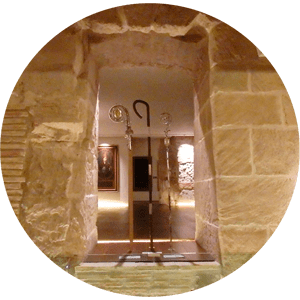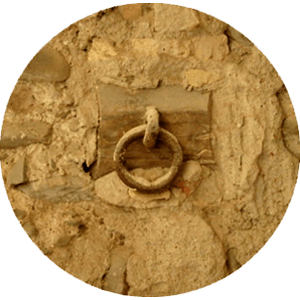You are about starting a tour around one thousand years of history. The Alma Mater Museum is located in the oldest part of archbishop’s palace, a building used as a residence for prelate and Kings of Aragon from the 12th century. This palace arises in a place previously occupied by Caesaraugusta roman forum. We move back to Roman Empire.
This museum combines permanent collection, with artists such as Raphael and Goya, and the historical building, underlying spaces such as the gothic chapel from 15th century where the Catholic Monarchs prayed, and the Gothic-Mudejar roof of the 14th palace in king Peter IV times. In this tour you will visit stances where Papa Luna, King Alphonse I “the Battler” and the Catholic Monarchs were accommodates, besides other many other historical characters. The contents of the museum are complemented by three audiovisuals.
You are about starting a tour around one thousand years of history. The Alma Mater Museum is located in the oldest part of archbishop’s palace, a building used as a residence for prelate and Kings of Aragon from the 12th century. This palace arises in a place previously occupied by Caesaraugusta roman forum. We move back to Roman Empire.
This museum combines permanent collection, with artists such as Raphael and Goya, and the historical building, underlying spaces such as the gothic chapel from 15th century where the Catholic Monarchs prayed, and the Gothic-Mudejar roof of the 14th palace in king Peter IV times. In this tour you will visit stances where Papa Luna, King Alphonse I “the Battler” and the Catholic Monarchs were accommodates, besides other many other historical characters. The contents of the museum are complemented by three audiovisuals.

![]()
This door and the rest of the reception move us back to 12th century. This space is the base of a tower built after the conquest of Zaragoza. Bishop Pedro of Librana ordered to build this tower some time later King Alphonse I, also known as “the Battler”, and his troop conquered Saraqusta (name given to the city in Muslim period). It was raised on a field gifted by the king and governor Gaston of Bearn, close to the city wall. From this tower, the building grew into different directions till what we see today.

This door and the rest of the reception move us back to 12th century. This space is the base of a tower built after the conquest of Zaragoza. Bishop Pedro of Librana ordered to build this tower some time later King Alphonse I, also known as “the Battler”, and his troop conquered Saraqusta (name given to the city in Muslim period). It was raised on a field gifted by the king and governor Gaston of Bearn, close to the city wall. From this tower, the building grew into different directions till what we see today.
![]()
These two crosiers are from the 20th century which belonged to Archbishops Rigoberto Dómenech and Elías Yanes. Crosiers have been used by bishops, archbishops and abbots as jurisdiction symbol since 7th century, in the Visigoth period.
Focusing on their design, they belong to modernist style, with neo-gothic details and some ornamentation inspired by Gothic miniatures, such as dragons interwoven.
In contrast to this meticulous decoration, it is underlined sobriety in Elias Yanes’s wooden crosier.

![]() In the 18th century, archbishop’s palace stable was situated in this same space. The ring in the walls is a reminder.
In the 18th century, archbishop’s palace stable was situated in this same space. The ring in the walls is a reminder.
These two crosiers are from the 20th century which belonged to Archbishops Rigoberto Dómenech and Elías Yanes. Crosiers have been used by bishops, archbishops and abbots as jurisdiction symbol since 7th century, in the Visigoth period.
Focusing on their design, they belong to modernist style, with neo-gothic details and some ornamentation inspired by Gothic miniatures, such as dragons interwoven.
In contrast to this meticulous decoration, it is underlined sobriety in Elias Yanes’s wooden crosier.

In the 18th century, archbishop’s palace stable was situated in this same space. The ring in the walls is a reminder.
